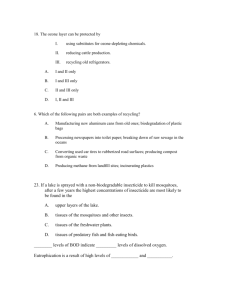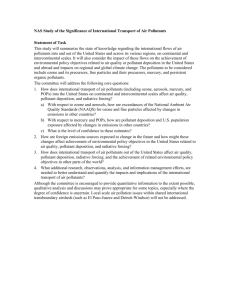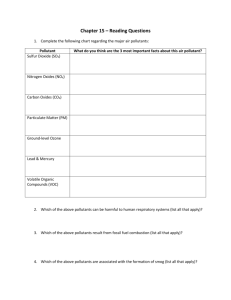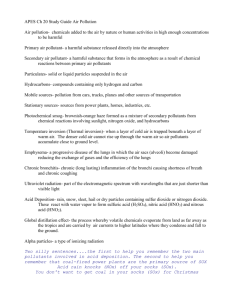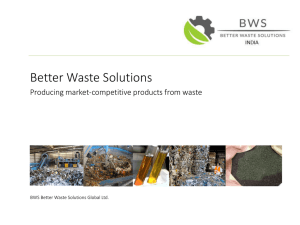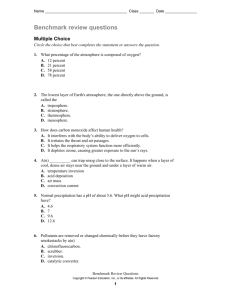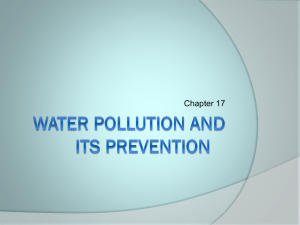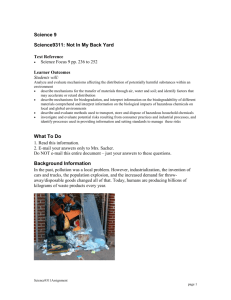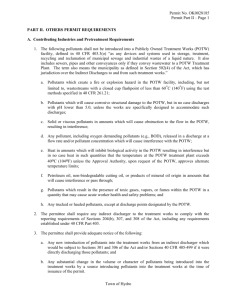sewage ozone
advertisement
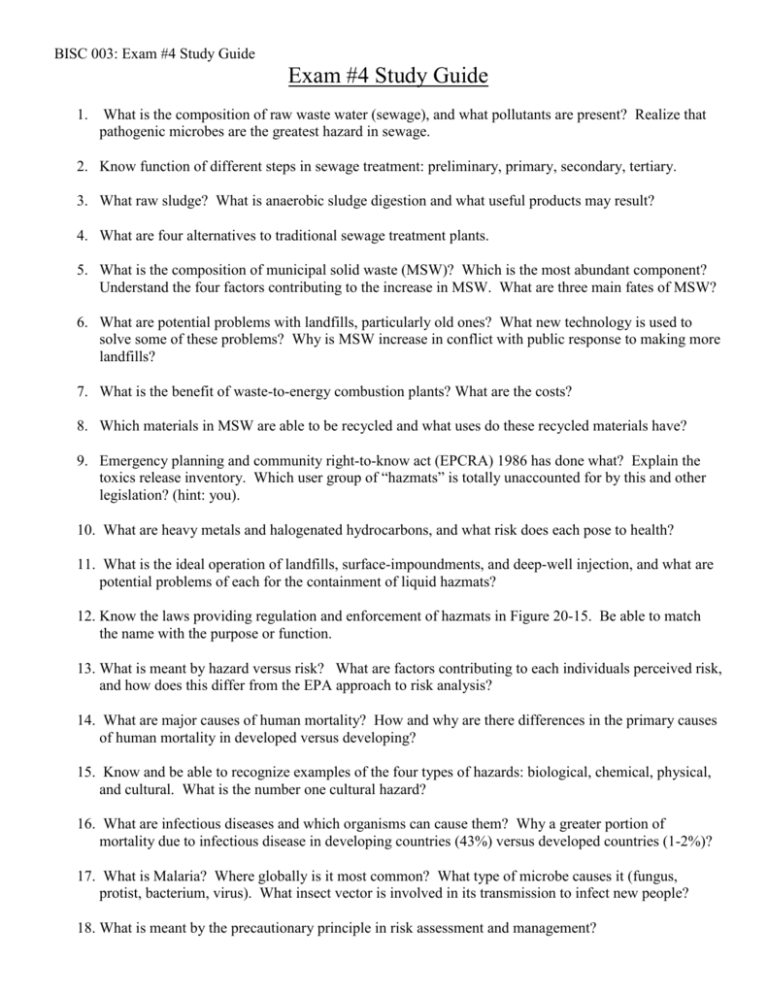
BISC 003: Exam #4 Study Guide Exam #4 Study Guide 1. What is the composition of raw waste water (sewage), and what pollutants are present? Realize that pathogenic microbes are the greatest hazard in sewage. 2. Know function of different steps in sewage treatment: preliminary, primary, secondary, tertiary. 3. What raw sludge? What is anaerobic sludge digestion and what useful products may result? 4. What are four alternatives to traditional sewage treatment plants. 5. What is the composition of municipal solid waste (MSW)? Which is the most abundant component? Understand the four factors contributing to the increase in MSW. What are three main fates of MSW? 6. What are potential problems with landfills, particularly old ones? What new technology is used to solve some of these problems? Why is MSW increase in conflict with public response to making more landfills? 7. What is the benefit of waste-to-energy combustion plants? What are the costs? 8. Which materials in MSW are able to be recycled and what uses do these recycled materials have? 9. Emergency planning and community right-to-know act (EPCRA) 1986 has done what? Explain the toxics release inventory. Which user group of “hazmats” is totally unaccounted for by this and other legislation? (hint: you). 10. What are heavy metals and halogenated hydrocarbons, and what risk does each pose to health? 11. What is the ideal operation of landfills, surface-impoundments, and deep-well injection, and what are potential problems of each for the containment of liquid hazmats? 12. Know the laws providing regulation and enforcement of hazmats in Figure 20-15. Be able to match the name with the purpose or function. 13. What is meant by hazard versus risk? What are factors contributing to each individuals perceived risk, and how does this differ from the EPA approach to risk analysis? 14. What are major causes of human mortality? How and why are there differences in the primary causes of human mortality in developed versus developing? 15. Know and be able to recognize examples of the four types of hazards: biological, chemical, physical, and cultural. What is the number one cultural hazard? 16. What are infectious diseases and which organisms can cause them? Why a greater portion of mortality due to infectious disease in developing countries (43%) versus developed countries (1-2%)? 17. What is Malaria? Where globally is it most common? What type of microbe causes it (fungus, protist, bacterium, virus). What insect vector is involved in its transmission to infect new people? 18. What is meant by the precautionary principle in risk assessment and management? BISC 003: Exam #4 Study Guide 19. Know the structure of the lower atmosphere (troposphere and stratosphere). What is climate versus weather? What are the causes of climate and ultimate energy source? 20. What would global climate be like without atmospheric circulation (wind) and ocean circulation? How does the ocean and atmosphere distribute heat across the globe, from tropics to poles? 21. What explains the long-term variation in global climate (23,000 to 100,000 y) versus shorter term variation (1000s of years) of glaciations and warming? 22. How does a green house gas interact with light versus heat energy. Which are the greenhouse gases? which are most abundance? Which are most potent? Which are increased by man or exclusively produced by man (how)? 23. How does emissions of carbon dioxide to the atmosphere by fossil fuel burning compare to the uptake (sink) of carbon dioxide by ocean and forests? How rapidly is carbon dioxide increasing? 24. What are impacts of global warming if predictions come true? 25. What causes El Nino and what is the consequence regionally in the eastern Pacific (i.e. off the Peruvian Coast), and elsewhere globally? 26. How is ozone generated in the stratosphere? Why is this considered “good ozone”? What damage can UV light cause? What compounds are involved in reducing stratospheric ozone levels, and where is this happening? What is the Montreal Protocol? 27. What factors control air pollution and when does it become a concern to health or the environment? 28. What are the seven primary air pollutants and what activities are the primary sources of each. 29. What are two major groups of secondary air pollutants? From which primary pollutants are each derived and how? What is the involvement of hydroxyl radicals and how do they form? 30. What are air pollution effects to health, environment and materials (asthetics)? 31. What are the two types of smogs and how is each formed? 32. The four kinds of dry deposition are acid rain, acid snow, acid fog, and acid dry fall-out. What region of the US has the greatest acid deposition and what is it’s primary origin? 33. Know and understand how aquatic and forest ecosystems may be impacted negatively by acid deposition. Why aren’t all ecosystems impacted equally when exposed to similar doses of acid deposition (think rock types)? 34. Across most of the US, have most communities engage in sustainable development over the past five decades? What is urban sprawl? Does it contribute to excessive resource use, pollution, and energy demands? 35. Why did the root causes of urban sprawl begin shortly after WWII? Know the five major factors. BISC 003: Exam #4 Study Guide 36. How is the natural environment changed by urban sprawl and what consequences does this have on ecosystem health and functions (“services”) like the hydrologic cycle. 37. What are the impacts to wildlife and ecosystem stability? Specifically, what mechanisms contribute to wildlife loss? 38. What has been the cause of exurban migration of the past decades, and how has this led to urban decay/blight? What have been (are) the consequences? 39. What is clustered development and what aspects make this a better approach to achieve social, economic and environmental sustainability. 40. Would a revitalized inner city be more sustainable and “livable” in the long term than expansive suburban development? BISC 003: Exam #4 Study Guide Exam #4 Vocabulary List raw waste water (sewage), human pathogens, preliminary treatement, primary clarifiers, raw sludge, secondary treatment, biological nutrient removal, sludge digesters, pasteurized, Municipal solid waste, landfill, LULU, NIMBY, NIMTOO, waste-to-energy, resource recovery, primary recycling, secondary recycling, Persistent organic pollutant, acute, chronic, carcinogenic, dose, exposure, threshold level, hazardous material, ignitability, corrosively, reactivity, toxicity, total product life cycle, halogenated hydrocarbons, organic chlorides, midnight dumping, groundwater remediation, bioremediation, phytoremediation, brownfields, discharge permit, Troposphere, tropopause, stratosphere, weather, climate, convection currents, isotopes, Milankovitch cycles, Ocean Conveyor, Thermohaline currents, greenhouse gases, Precautionary Principle, Ozone shield, chlorine cycle, Montreal Protocol air pollutants, hydroxyl radical, chlorotic, necrotic, corrosion, oxidation, industrial smog, photochemical smog, temperature inversion, particulates, VOCs, CO, NOx, SOx, lead, primary pollutants, secondary pollutants, nitrogen oxides, emissions, tropospheric ozone, photochemical oxidants, sulfuric acid, nitric acid, acid deposition, pH, acid precipition, buffer, Urban sprawl, exurban migration, suburbs/exurbs, urban blight/decay, economic exclusion, clustered development
